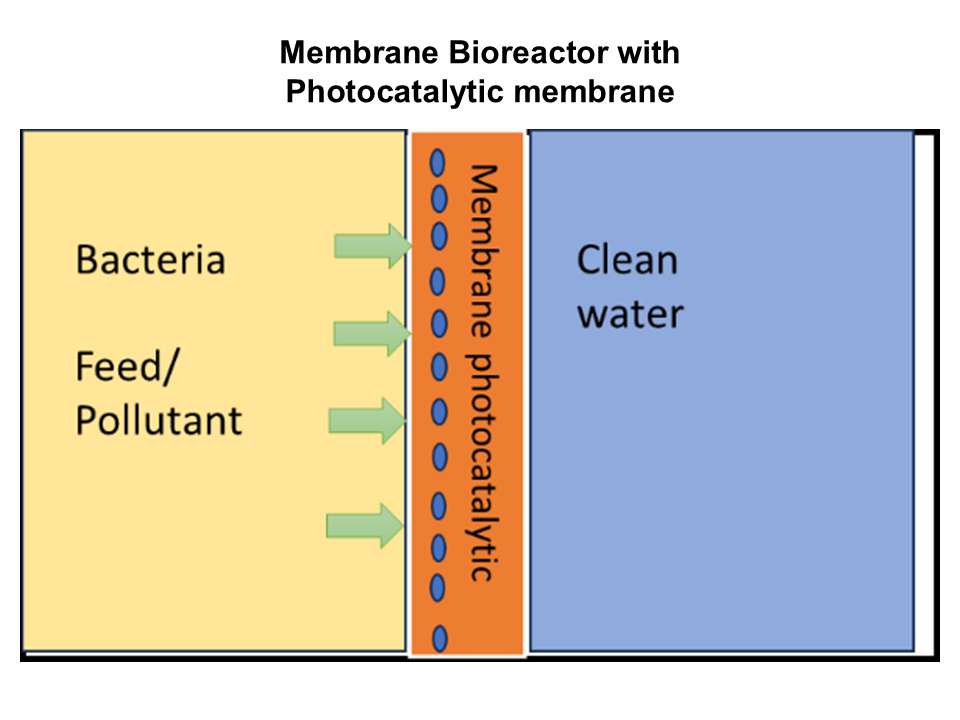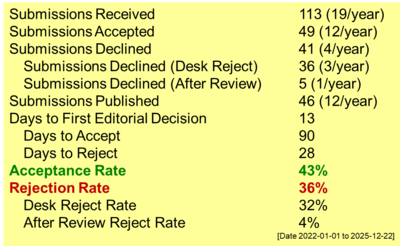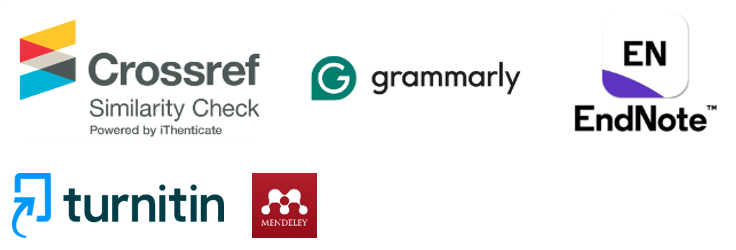The Potency of Photocatalytic Membrane Bioreactor for Wastewater Treatment: A Brief Review
DOI:
https://doi.org/10.55749/ijcs.v4i1.63Keywords:
Antifouling, Biofouling, Bioreactor, Membrane, photocatalystAbstract
Membrane bioreactors (MBR) are a promising method for wastewater treatment that combines microbial degradation with membrane separation. MBRs offer efficient and sustainable wastewater treatment by combining biological processes with membrane filtration, providing high-quality effluents for reuse. The advantages of MBRs, such as their compact design, reduced sludge production, and water recycling potential, make them increasingly significant in addressing global water scarcity and pollution challenges. Nevertheless, the issue of biofouling persists as a notable obstacle, primarily caused by the interplay of bacteria, membrane surfaces, and the release of extracellular polymeric substances (EPS). Integrating photocatalysts into MBR membranes offers a new method to reduce fouling. This study provides a comprehensive overview of current research on the membrane modification using photocatalysts in MBR systems, focusing on the existing challenges and prospects in this field. Despite these potential advantages, research on improving MBR membrane performance through photocatalysis is sparse. To ensure the sustainability of this technology, it is essential to consider important factors, such as reactor configuration, kinetics, fouling processes, economic feasibility, and scaling issues
References
Fane, A.G. & Fane, S.A. 2018. The role of membrane technology in sustainable decentralized wastewater systems. Water Sci. technol. 5(10). 317–325. doi: https://doi.org/10.2166/wst.2005.0381.
Judd, S.J. 2016. The status of industrial and municipal effluent treatment with membrane bioreactor technology. Chem. Eng. J. 305. 37–45. doi: https://doi.org/10.1016/j.cej.2015.08.141.
Plakas, K.V, Sarasidis, V.C., Patsios, S.I., Lambropoulou, D.A., & Karabelas, A.J. 2016. Novel pilot scale continuous photocatalytic membrane reactor for removal of organic micropollutants from water. Chem. Eng. J. 304. 335–343. doi: https://doi.org/10.1016/j.cej.2016.06.075.
AlSawaftah, N., Abuwatfa, W., Darwish, N., & Husseini, G.A. 2022. A review on membrane biofouling: prediction, characterization, and mitigation. membranes (basel). Membranes. 12(12). 1271. doi: https://doi.org/10.3390/membranes12121271.
Millanar-Marfa, J.M.J., Borea, L., Hasan, S.W., de Luna, M.D.G., Belgiorno, V., & Naddeo, V. 2020. Advanced membrane bioreactors for emerging contaminant removal and quorum sensing control. In Current Developments in Biotechnology and Bioengineering. pp. 117-147. doi: https://doi.org/10.1016/B978-0-12-819854-4.00006-X.
Patsios, S.I., Goudoulas, T.B., Kastrinakis, E.G., Nychas, S.G., & Karabelas, A.J. 2015. A novel method for rheological characterization of biofouling layers developing in Membrane Bioreactors (MBR). J. Memb. Sci. 482. 13–24. doi: https://doi.org/10.1016/j.memsci.2015.02.016.
Kang, G. & Cao, Y. 2014. Application and modi fi cation of poly (vinylidene fl uoride) (PVDF) membranes–A review. J. Membr. Sci. 463. 145–165. doi: https://doi.org/10.1016/j.memsci.2014.03.055.
Matar, G., Gonzalez-Gil, G., Maab, H., Nunes, S., Le-Clech, P., Vrouwenvelder, J., & Saikaly, P.E. 2016. Temporal changes in extracellular polymeric substances on hydrophobic and hydrophilic membrane surfaces in a submerged membrane bioreactor. Water Res. 95. 27–38. doi: https://doi.org/10.1016/j.watres.2016.02.064.
Binazadeh, M., Rasouli, J., Sabbaghi, S., Mousavi, S.M., Hashemi, S.A., & Lai, C.W. 2023. An overview of photocatalytic membrane degradation development. Materials (Basel). 16(9). 3526. doi: https://doi.org/10.3390/ma16093526.
Zheng, X., Shen, Z.P., Shi, L., Cheng, R., & Yuan, D.H. 2017. Photocatalytic membrane reactors (PMRs) in water treatment: Configurations and influencing factors. Catalysts. 7(8). 224. doi: https://doi.org/10.3390/catal7080224.
Hastuti, L.P., Kusumaatmaja, A., & Kartini, I. 2021. Fabrication of electrospun multi-walled carbon nanotube/TiO2 nanofiber. Key Eng. Mater. 884. 67–73. doi: https://doi.org/10.4028/www.scientific.net/KEM.884.67.
Song, J., Wu, X., Zhang, M., Liu, C., Yu, J., Sun, G., & Si, Y. 2020. based nano fibrous membranes for antibiotic removal and E . coil inactivation. Chem. Eng. J. 379. 122269. doi: https://doi.org/10.1016/j.cej.2019.122269.
Liyana, A., Hanis, N., Hairom, H., Abu, D., Sidik, B., Misdan, N., Yusof, N., Khairul, M., & Wahab, A. 2019. Journal of Environmental Chemical Engineering A comparative study of ZnO-PVP and ZnO-PEG nanoparticles activity in membrane photocatalytic reactor (MPR) for industrial dye wastewater treatment under di ff erent membranes. J. Environ. Chem. Eng. 7(3). 103143. doi: https://doi.org/10.1016/j.jece.2019.103143.
Liu, X., Yang, H., Dai, H., Mao, X., & Liang, Z. 2015. A novel photoelectrocatalytic approach for water splitting by an I-BiOCl/bipolar membrane sandwich structure. Green Chem. 17(1). 199–203. doi: https://doi.org/10.1039/c4gc01610f.
Hastuti, L.P., Kusumaatmaja, A., Darmawan, A., & Kartini, I. 2023. Durable photocatalytic membrane of PAN/TiO2/CNT for methylene blue removal through a cross-flow membrane reactor. Sep. Sci. Technol. 58(4). 704–720. doi: https://doi.org/10.1080/01496395.2022.2145221.
Fazal, S., Zhang, B., Zhong, Z., Gao, L., & Chen, X. 2015. Industrial wastewater treatment by using MBR (Membrane Bioreactor) review study. J. Environ. Prot. 6(6). 584–598. doi: https://doi.org/10.4236/jep.2015.66053.
Barberio, M., Imbrogno, A., Grosso, D.R., Bonanno, A., & Xu, F. 2015. Study of dye absorption in carbon nanotube-titanium dioxide heterostructures. J. Chem. Chem. Eng. 9. 245–252. doi: https://doi.org/10.17265/1934-7375/2015.04.002.
He, Z., Zhang, Q., Wei, Z., Zhao, Y., & Pan, X. 2019. Science of the total environment cultivation of a versatile manganese-oxidizing aerobic granular sludge for removal of organic micropollutants from wastewater. Sci. Total Environ. 690. 417–425. doi: https://doi.org/10.1016/j.scitotenv.2019.06.509.
Cortés-López, A.J., Muñoz-Sandoval, E., & López-Urías, F. 2018. Efficient carbon nanotube sponges production boosted by acetone in CVD-Synthesis. Carbon. 135. 145–156. doi: https://doi.org/10.1016/j.carbon.2018.04.046.
Lamsal, R., Walsh, M.E., & Gagnon, G.A. 2011. Comparison of advanced oxidation processes for the removal of natural organic matter. Water Res. 45(10). 3263–3269. doi: https://doi.org/10.1016/j.watres.2011.03.038.
Lee, H.S. & Liao, B. 2021. Anaerobic membrane bioreactors for wastewater treatment: challenges and opportunities. Water Environ. Res. 93(7). 993–1004. doi: https://doi.org/10.1002/wer.1475.
Singh, D., Satpute, S.K., Ranga, P., Saharan, B.S., Tripathi, N.M., Aseri, G.K., Sharma, D., & Joshi, S. 2023. Biofouling in membrane bioreactors: mechanism, interactions and possible mitigation using biosurfactants. Appl. Biochem. Biotechnol. 195(3). 2114–2133. doi: https://doi.org/10.1007/s12010-022-04261-4.
Al-Asheh, S., Bagheri, M., & Aidan, A. 2021. Membrane bioreactor for wastewater treatment: A review. Case Stud. Chem. Environ. Eng. 4. 100109. doi: https://doi.org/10.1016/j.cscee.2021.100109.
Yang, Y., Qiao, S., Jin, R., Zhou, J., & Quan, X. 2019. Novel anaerobic electrochemical membrane bioreactor with a CNTs hollow fiber membrane cathode to mitigate membrane fouling and enhance energy recovery. Environ. Sci. Technol. 53(2). 1014–1021. doi: https://doi.org/10.1021/acs.est.8b05186.
Inaba, T., Hori, T., Aizawa, H., Ogata, A., & Habe, H. 2017. Architecture, component, and microbiome of biofilm involved in the fouling of membrane bioreactors. npj Biofilms Microbiomes. 3(1). 5. doi: https://doi.org/10.1038/s41522-016-0010-1.
Meng, F., Chae, S.R., Drews, A., Kraume, M., Shin, H.S., & Yang, F. 2009. Recent advances in membrane bioreactors (MBRs): Membrane fouling and membrane material. Water Res. 43(6). 1489–1512. doi: https://doi.org/10.1016/j.watres.2008.12.044.
Le-Clech, P., Chen, V., & Fane, T.A.G. 2006. Fouling in membrane bioreactors used in wastewater treatment. J. Memb. Sci. 284(1–2). 17–53. doi: https://doi.org/10.1016/j.memsci.2006.08.019.
Sabalanvand, S., Hazrati, H., Jafarzadeh, Y., Jafarizad, A., & Gharibian, S. 2021. Investigation of Ag and magnetite nanoparticle effect on the membrane fouling in membrane bioreactor. Int. J. Environ. Sci. Technol. 18(11). 3407–3418. doi: https://doi.org/10.1007/s13762-020-03053-9.
Ni, L., Zhu, Y., Ma, J., & Wang, Y. 2021. Novel strategy for membrane biofouling control in MBR with CdS/MIL-101 modified PVDF membrane by in situ visible light irradiation. Water Res. 188. 116554. doi: https://doi.org/10.1016/j.watres.2020.116554.
Takimoto, Y., Hatamoto, M., Soga, T., Kuratate, D., Watari, T., & Yamaguchi, T. 2021. Maintaining microbial diversity mitigates membrane fouling of an anoxic/oxic membrane bioreactor under starvation condition. Sci. Total Environ. 759. 143474. doi: https://doi.org/10.1016/j.scitotenv.2020.143474.
Ni, L., Shi, Q., Wu, M., Ma, J., & Wang, Y. 2021. Fouling behavior and mechanism of hydrophilic modified membrane in anammox membrane bioreactor: Role of gel layer. J. Memb. Sci. 620. 118988. doi: https://doi.org/10.1016/j.memsci.2020.118988.
Maaz, M., Yasin, M., Aslam, M., Kumar, G., Atabani, A.E., Idrees, M., Anjum, F., Jamil, F., Ahmad, R., Khan, A.L. and Lesage, G. 2019. Anaerobic membrane bioreactors for wastewater treatment: Novel configurations, fouling control and energy considerations. Bioresour. Technol. 283. 358–372. doi: https://doi.org/10.1016/j.biortech.2019.03.061.
Shoener, B.D., Zhong, C., Greiner, A.D., Khunjar, W.O., Hong, P.Y., & Guest, J.S. 2016. Design of anaerobic membrane bioreactors for the valorization of dilute organic carbon waste streams. Energy Environ. Sci. 9(3). 1102–1112. doi: https://doi.org/10.1039/c5ee03715h.
Liao, Y., Bokhary, A., Maleki, E., & Liao, B. 2018. A review of membrane fouling and its control in algal-related membrane processes. Bioresour. Technol. 264. 343–358. doi: https://doi.org/10.1016/j.biortech.2018.06.102.
Leong, S., Razmjou, A., Wang, K., Hapgood, K., Zhang, X., & Wang, H. 2014. TiO2 based photocatalytic membranes: A review. J. Memb. Sci. 472. 167–184. doi: https://doi.org/10.1016/j.memsci.2014.08.016.
Wu, H., Xu, X., Shi, L., Yin, Y., Zhang, L.C., Wu, Z., Duan, X., Wang, S., & Sun, H. 2019. Manganese oxide integrated catalytic ceramic membrane for degradation of organic pollutants using sulfate radicals. Water Res. 167. 115110. doi: https://doi.org/10.1016/j.watres.2019.115110.
Hastuti, L.P., Kusumaatmaja, A., Darmawan, A., & Kartini, I. 2022. Photocatalytic membrane of TiO2/CNT decorated PAN nanofibers with enhanced performance under LED visible-light irradiation. Energy Environ. doi: https://doi.org/10.1177/0958305X221108494.
Sakhaie, S. & Taghipour, F. 2023. Highly durable zirconium/titanium dioxide–silicon carbide photocatalytic membrane for water and wastewater treatment. J. Environ. Chem. Eng. 11(3). doi: https://doi.org/10.1016/j.jece.2023.110142.
Liu, G., Han, K., Zhou, Y., Ye, H., Zhang, X., Hu, J., & Li, X. 2018. Facile Synthesis of Highly Dispersed Ag Doped Graphene Oxide/Titanate Nanotubes as a Visible Light Photocatalytic Membrane for Water Treatment. ACS Sustain. Chem. Eng. 6(5). 6256–6263. doi: https://doi.org/10.1021/acssuschemeng.8b00029.
Lyubimenko, R., Busko, D., Richards, B.S., Schäfer, A.I., & Turshatov, A. 2019. Efficient Photocatalytic Removal of Methylene Blue Using a Metalloporphyrin-Poly(vinylidene fluoride) Hybrid Membrane in a Flow-Through Reactor. ACS Appl. Mater. Interfaces. 11(35). 31763–31776. doi: https://doi.org/10.1021/acsami.9b04601.
Mastropietro, T.F., Meringolo, C., Poerio, T., Scarpelli, F., Godbert, N., Di Profio, G., & Fontananova, E. 2017. Multistimuli Activation of TiO2/α-alumina membranes for degradation of methylene blue. Ind. Eng. Chem. Res. 56(39). 11049–11057. doi: https://doi.org/10.1021/acs.iecr.7b02778.
Liu, L., Liu, Z., Bai, H., & Sun, D.D. 2012. Concurrent filtration and solar photocatalytic disinfection/degradation using high-performance Ag/TiO2 nanofiber membrane. Water Res. 46(4). 1101–1112. doi: https://doi.org/10.1016/j.watres.2011.12.009.
Papageorgiou, S.K., Katsaros, F.K., Favvas, E.P., Romanos, G.E., Athanasekou, C.P., Beltsios, K.G., Tzialla, O.I., & Falaras, P. 2012. Alginate fibers as photocatalyst immobilizing agents applied in hybrid photocatalytic / ultrafiltration water treatment processes. Water Res. 46(6). 1858–1872. doi: https://doi.org/10.1016/j.watres.2012.01.005.
Goei, R., Dong, Z., & Lim, T.T. 2013. High-permeability pluronic-based TiO2 hybrid photocatalytic membrane with hierarchical porosity: Fabrication, characterizations and performances. Chem. Eng. J. 228. 1030–1039. doi: https://doi.org/10.1016/j.cej.2013.05.068.
Athanasekou, C.P. et al. 2015. Ceramic photocatalytic membranes for water filtration under UV and visible light. Appl. Catal. B Environ. 178. 12–19. doi: https://doi.org/10.1016/j.apcatb.2014.11.021.
Pastrana-Martínez, L.M., Morales-Torres, S., Figueiredo, J.L., Faria, J.L., & Silva, A.M.T. 2015. Graphene oxide based ultrafiltration membranes for photocatalytic degradation of organic pollutants in salty water. Water Res. 77. 179–190. doi: https://doi.org/10.1016/j.watres.2015.03.014.
Zhang, H., Quan, X., Chen, S., Zhao, H., & Zhao, Y. 2006. Fabrication of photocatalytic membrane and evaluation its efficiency in removal of organic pollutants from water. Sep. Purif. Technol. 50(2). 147–155. doi: 10.1016/j.seppur.2005.11.018.
Argurio, P., Fontananova, E., Molinari, R., & Drioli, E. 2018. Photocatalytic membranes in photocatalytic membrane reactors. Processes. 6(9). 162. doi: https://doi.org/10.3390/pr6090162.
Corredor, J., Perez-Peña, E., Rivero, M.J., & Ortiz, I. 2020. Performance of rgo/TiO2 photocatalytic membranes for hydrogen production. Membranes. 10(9). 1–13. doi: https://doi.org/10.3390/membranes10090218.
Ni, L., Wang, K., Wang, Z., & Wang, Y. 2022. Antibiofouling characteristics and mechanisms in an anammox membrane bioreactor based on an optimized photocatalytic technology─photocatalytic optical fibers. Environ. Sci. Technol. 56(22). 16144–16155. doi: https://doi.org/10.1021/acs.est.2c04023.
Ni, L., Wang, K., Wang, Z., & Wang, Y. 2022. Antibiofouling Characteristics and Mechanisms in an Anammox Membrane Bioreactor Based on an Optimized Photocatalytic Technology─Photocatalytic Optical Fibers. Environ. Sci. Technol. 56(22). 16144-16155. doi: https://doi.org/10.1021/acs.est.2c04023.
Luo, J., Chen, W., Song, H., & Liu, J. 2020. Fabrication of hierarchical layer-by-layer membrane as the photocatalytic degradation of foulants and effective mitigation of membrane fouling for wastewater treatment. Sci. Total Environ. 699. 134398. doi: https://doi.org/10.1016/j.scitotenv.2019.134398.
Zhang, H., Wan, Y., Luo, J., & Darling, S.B. 2021. Drawing on Membrane Photocatalysis for Fouling Mitigation. ACS Appl. Mater. Interfaces. 13(13). 14844–14865. doi: https://doi.org/10.1021/acsami.1c01131.
Zhang, Y., Wang, S., You, S., Wang, J., Wang, J., Jia, L., Zhang, H., & Zhang, M. 2023. Fabrication of transparent and hazy cellulosic light-management film for enhancing photon utilization in photocatalytic membrane process. J. Memb. Sci. 685. doi: https://doi.org/10.1016/j.memsci.2023.121923.
Molinari, R., Marino, T., & Argurio, P. 2014. Photocatalytic membrane reactors for hydrogen production from water. Int. J. Hydrogen Energy. 39(14). 7247–7261. doi: https://doi.org/10.1016/j.ijhydene.2014.02.174.

Downloads
Published
How to Cite
Issue
Section
License
Copyright (c) 2025 Indonesian Journal of Chemical Studies

This work is licensed under a Creative Commons Attribution-ShareAlike 4.0 International License.



















